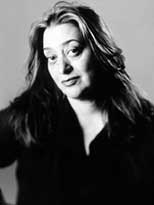World-renowned architect Zaha Hadid presented an overview of her astonishing body of work to a capacity crowd in Room 10-250 on April 10. Her talk, entitled "Total Fluidity on All Scales," was the 19th annual Arthur H. Schein Memorial Lecture, given in memory of an honored MIT architecture alumnus who died in 1983.
Visiting associate professor of architecture Sanford Kwinter, who introduced the speaker, called Hadid "one of the world's most distinguished architects," whose work reflects "a universe not of grids but of vortexes."
"Hadid's work both transposes and displaces the very horizon that serves as our orientation point in the world. Her curves careen across the canvas or page, as if to mock the straight lines that they partly portray," he said.
The Baghdad-born Hadid, currently the Eero Saarinen Visiting Professor of Architecture at Yale University, is the only woman to have won the Pritzker Architectural Prize, the field's highest honor. She studied in the 1970s at London's Architectural Association before establishing her own practice in that city. Zaha Hadid Architects currently employs some 200 architects and executes projects, large and small, all over the world. The Guggenheim Museum in New York exhibited a retrospective of her work, including a number of her paintings, in the fall of 2006.
Fluidity on every scale was the theme of Hadid's presentation at MIT, as it is the hallmark of her work. Starting with her smallest-scale projects, she showed the audience slides of the streamlined cutlery she designed for WMF, one of Europe's largest cutlery manufacturers. (The limited-production five-piece set retails for $250.) The scale moved up from there, through chandeliers and handbags to furnishings, cars, hotel rooms, private homes, civic and commercial buildings, right through to skyscrapers and entire urban fabrics. She showed a series of seamless, sculptural shelves that, as she put it, are "almost like calligraphy or dancing figures on a wall."
Although some, as Kwinter noted, have criticized her work as "paper architecture"--that is, unbuildable--the dozens of executed projects Hadid presented over the course of her lecture constitute an answer to these critics. From the sweeping Bergisel Ski Jump in Innsbruck, Austria, to the Ordrupgaard Museum Extension in Copenhagen, her extant works playfully defy common geometry and even gravity while paying close attention to the needs and motivations of the clients.
Her airy design for the BMW central plant in Leipzig, Germany, completed in 2006, broke down physical and psychological barriers between manufacturing and management with a "mix of blue--and white--collar workers." Manufacturing, management and design are now all under one roof, with the cars shuttling (quietly) between painting and storage right past executives' offices. One cafeteria now serves everyone, from the cleaning staff to the top management.
The scale of Hadid's projects has extended beyond individual buildings to rethinking entire urban regions. Currently on track is a master plan for Zorrozaurre, a neglected and ill-connected island in Bilbao, Spain. Hadid's dynamic, curving lines of development--bending streets but also constructing numerous bridges to connect the island with the rest of the city--will change a stagnated grid-plan into a dynamic urban mix of residential, commercial and open space and working infrastructure.
As one MIT architecture grad student, who showed up 45 minutes early to get a seat to Hadid's lecture, commented, "She's kind of an icon."
A version of this article appeared in MIT Tech Talk on April 25, 2007 (download PDF).






